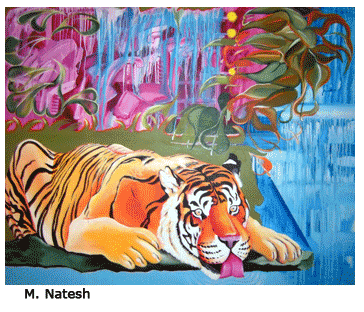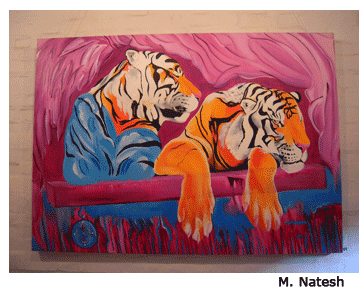- Prelude
- Guest Editor’s Column
- Hard Talk
- Eloquence of Silence
- The Age of Revivals: Gothic Revival Furniture
- Inkwell
- New Media : Living up to the chivalric code
- Universalizing Art through Individual Langue
- Speaking New Discourses
- Video Art of India- Gigi Scaria and his Videos
- Contemporary Trends of Sculpting
- In the News
- Artist Index and Statistics
- Market Insight
- Auction Reports
- The month that was
- Art Bengaluru
- Mumbai Artsighting
- Musings from Chennai
- Deccan Odyssey
- Delhi Dias
- In between – from Vadodara
- North-East Opsis
- A Tryst with Art in Madhya Pradesh
- Tradition and Beyond
- Reverie
- Indian (Sub) Way
- Creative Impulse
- Different hues of Aakriti
ART news & views
Musings from Chennai
Volume: 2 Issue No: 8 Month: 9 Year: 2010
From August 15th to 22nd, Chennai celebrates 'Madras Week' to commemorate the founding of the city in the 17th century. While Madras followed many other cities in changing its name from an angelicised to a regional one, this city is particularly known for the strong passions that are easily be aroused by language. In this context, identity is defined less in terms of geography and more in reference to the language. Ironically the language itself (or 'herself' if one were to go by the gendered personification of the tongue) defines identity as not being fixed through statements like 'Yaadhum Oore Yaavarum Kelir”, meaning 'All places and people are like one's own'.  One can perhaps say that the art produced in Chennai shares a close relationship with the word which is used both as a tool of formal innovation and also as a textual source of reference. Many artists of the Madras Art Movement, a movement that searched for Indian identity in the international art world, looked at language (though not necessarily Tamil) and its script for inspiration. In more recent times, painting has also been used to propagate and create a sense of Tamil identity, especially in the face of globalisation by illustrating ancient Tamil epics. One of the subways leading to the Marina Beach, which could be compared to a threshold space since it is a place that any visitor from outside Chennai would visit, is painted with representations of stories from the Tamil epic Silappadhikaram. Over these affirmations of Tamil identity are further stamps of personal identity in the form of graffiti. The close relationship between writing and painting in art brings to mind, Rabindranath Tagore. Significantly, Bengali artists have always been a favourite in Chennai's gallery circuit with galleries like Sarala's Art world, Prakrit Arts often holding exhibitions of Bengali artists. August 15th onwards, Sarala's Art World begins an exhibition of senior artists from Kolkotta such as Rabin Mondal, Ganesh Haloi etc.
One can perhaps say that the art produced in Chennai shares a close relationship with the word which is used both as a tool of formal innovation and also as a textual source of reference. Many artists of the Madras Art Movement, a movement that searched for Indian identity in the international art world, looked at language (though not necessarily Tamil) and its script for inspiration. In more recent times, painting has also been used to propagate and create a sense of Tamil identity, especially in the face of globalisation by illustrating ancient Tamil epics. One of the subways leading to the Marina Beach, which could be compared to a threshold space since it is a place that any visitor from outside Chennai would visit, is painted with representations of stories from the Tamil epic Silappadhikaram. Over these affirmations of Tamil identity are further stamps of personal identity in the form of graffiti. The close relationship between writing and painting in art brings to mind, Rabindranath Tagore. Significantly, Bengali artists have always been a favourite in Chennai's gallery circuit with galleries like Sarala's Art world, Prakrit Arts often holding exhibitions of Bengali artists. August 15th onwards, Sarala's Art World begins an exhibition of senior artists from Kolkotta such as Rabin Mondal, Ganesh Haloi etc.
In Chennai, despite the important role that language plays in giving a sense of identity to art, painting that has a relationship with the former, need not necessarily meet with success. For example, Natesh's paintings and sensuous, black and white ink drawings that often blur the thin line between 'fine art' and illustration are yet to get the acclaim that is due to them. Last month saw an exhibition of his paintings depicting tigers coinciding with the screening of Sekar Dattatri’s documentary 'Truth about Tigers'. Interestingly, the tiger is an animal caught not only in the net of poachers but also in the trappings of signifying national identities and subversive regional nationalisms, which are manifest through mainstream films, graffiti and also contemporary art exhibitions.
Places not only play a role in defining the people and objects but also twist the way different mediums are perceived.  While Bangalore has become known for its 'new media' art, where even the statement that 'new media is no longer new' itself has become old, in Chennai 'new media' still remains relatively new. At times, even when 'new media' is used, the usage of the medium takes after the effects and themes popular to paintings in the region, such as in the case of N.Srinivasan’s digital paintings which are derived from memories of his village and from Saiva Siddhantic philosophy. Incidentally, Saiva Siddhanta, a system of philosophy specific to Tamil Nadu, contributed to making the iconic the dancing image of Nataraja, an image that has in recent times become symbolic of a particular medium (bronze), time period (Chola) and art form (dance).
While Bangalore has become known for its 'new media' art, where even the statement that 'new media is no longer new' itself has become old, in Chennai 'new media' still remains relatively new. At times, even when 'new media' is used, the usage of the medium takes after the effects and themes popular to paintings in the region, such as in the case of N.Srinivasan’s digital paintings which are derived from memories of his village and from Saiva Siddhantic philosophy. Incidentally, Saiva Siddhanta, a system of philosophy specific to Tamil Nadu, contributed to making the iconic the dancing image of Nataraja, an image that has in recent times become symbolic of a particular medium (bronze), time period (Chola) and art form (dance).
With globalisation asserting itself over the city a greater awareness of regional cultural heritage and the need to celebrate it by mapping histories of art and architecture has emerged, leading to events like the Madras Week. 'Present in the Past' is an ongoing exhibition of art works by Rm.Palaniappan, K.Muralidharan, C.Douglas, Shalini Biswajit, A.V.Illango, G.Gurunathan and many others organised by Forum Art Gallery in order to celebrate this week. However, writing on the Madras Canvas II, a yearly exhibition organised by Forum Art Gallery that aims to create a “collective, representative exhibition of the city's artists”, Sadanand Menon says “It is clear that only a new realigment with arts will enable this city to confer upon itself the dignity of an honest and civilized quest, a new urbanisation that leaps over the physical, psychological and aesthetic violence that the city has come to represent in recent times”.